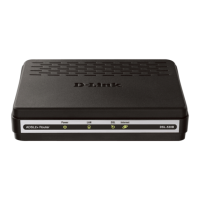Section 1 - Product Overview
Features
11
• PPP (Point-to-Point Protocol) Security – The DSL-520B ADSL Router supports PAP (Password Authentication Protocol) and CHAP
(Challenge Handshake Authentication Protocol) for PPP connections. The Router also supports MSCHAP.
• DHCP Support – Dynamic Host Configuration Protocol automatically and dynamically assigns all LAN IP settings to each host on your
network. This eliminates the need to reconfigure every host whenever changes in the network topology occur.
• Network Address Translation (NAT) – For small office environments, the DSL-520B allows multiple users on the LAN to access the
Internet concurrently through a single Internet account. This provides Internet access to everyone in the office for the price of a single user.
NAT improves network security in effect by hiding the private network behind one global and visible IP address. NAT address mapping can
also be used to link two IP domains via a LAN-to-LAN connection.
• TCP/IP (Transmission Control Protocol/Internet Protocol) – The DSL-520B supports the TCP/IP protocol, the language used for the
Internet. It is compatible with access servers manufactured by major vendors.
• RIP-1/RIP-2 – The DSL-520B supports both RIP-1 and RIP-2 exchanges with other routers. Using both versions allows the Router to
communicate with all RIP enabled devices.
• Static Routing – This allows you to select a data path to a particular network destination that will remain in the routing table and never “age
out”. Create a static route if you wish to define a specific route that will always be used for data traffic from your LAN to a specific destination
within your LAN (for example to another router or a server) or to a specific destination outside your network (to an ISP defined default
gateway for instance).
• Default Routing – This allows you to choose a default path for incoming data packets for which the destination address is unknown. This is
particularly useful when/if the Router functions as the sole connection to the Internet.
• ATM (Asynchronous Transfer Mode) – The DSL-520B supports Bridged Ethernet over ATM (RFC1483), IP over ATM (RFC1577), and PPP
over ATM (RFC 2364).
• Precise ATM Traffic Shaping – Traffic shaping is a method of controlling the flow rate of ATM data cells. This function helps to establish the
Quality of Service for ATM data transfer.
• G.hs (Auto-handshake) – This allows the Router to automatically choose either the G.lite or G.dmt ADSL connection standards.
• High Performance – Very high rates of data transfer are possible with the Router. Up to 8 Mbps downstream bit rate is possible using the
G.dmt standard.
• Telnet Connection – Telnet enables a network manager to access the Router’s management software remotely.
• Easy Installation – The DSL-520B uses a web-based graphical user interface program for convenient management access and easy set up.
Any common web browser software can be used to manage the Router.
D-Link DSL-520B User Manual
3

